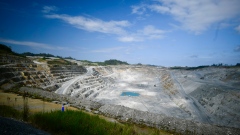May 8, 2024
Turkey’s Inflation Math Is No Longer a Dealbreaker for Investors
, Bloomberg News

(Bloomberg) -- Turkish inflation forecasts still strain belief — but this time, few in the market are complaining.
As Governor Fatih Karahan prepares to unveil the central bank’s fresh outlook at a quarterly event in Ankara on Thursday, investor focus is instead on how monetary policy aligns with a goal that a top official calls “ambitious but attainable.” It envisions inflation almost halving to 36% by the end of the year, a view more optimistic than the predictions of all but one analyst surveyed by Bloomberg.
Overly sanguine projections under the central bank’s previous leadership were once a turnoff for investors already alienated by ultra-low interest rates as consumer prices spiraled out of control. Now, however, the central bank sees its forecasts as targets meant to shape policy while doing “whatever it takes” to smother inflation.
A decision to maintain this year’s forecast at 36% for a second quarter would actually support inflows into local bonds if accompanied by a signal of additional tightening, said Altug Ozaslan, chief executive officer of investment consultancy Fortuna Capital.
“Investors’ conviction in the monetary policy and possible moves to further tighten liquidity are key to increase the appeal and draw inflows into government bonds,” said Ozaslan.
Almost a year into Turkey’s embrace of more conventional economics, an audience that awaits Karahan and his two deputies is in a more forgiving mood. Still, the event is a rare opportunity to grill policymakers over what’s next with inflation running faster than in Venezuela and rates at nearly minus 20% when adjusted for current prices.
Turkish officials prefer to look at the differential between borrowing costs and the central bank’s projected path for inflation, a view that suggests policy is already tighter than would appear otherwise. By that measure, rates have been positive since last November.
The presentation this month coincides with an expected peak in Turkish price growth at over 70%, before disinflation likely sets in from June thanks to the statistical effect of a high base from 2023 and as nine rate hikes filter through to the economy.
Elevated inflation expectations and brisk domestic demand are among the obstacles that stand in the way. Still, Karahan said last month that price growth was on track to end the year at 36% as planned — a level that markets see achieved only with a three-month lag.
“A central bank that has an unambitious target is an oxymoron,” Deputy Governor Cevdet Akcay said at the presentation of the last inflation report in February. The following month, policymakers surprised with a 500 basis-point hike that brought their key rate to 50%.
Economists differ over what, if anything, might change in the new outlook. Morgan Stanley expects the central bank’s year-end calls to stay the same “as it sees them as intermediate inflation targets.”
Analysts at Goldman Sachs Group Inc. instead anticipate policymakers could raise the mid-point of their projection to 38% and possibly “narrow the uncertainty band as we are closer to the end of the year.” The upper bound of the central bank’s forecast range is currently at 42%.
“Domestic demand conditions remain strong, and are likely to limit the improvement in inflation,” Barclays Plc economists including Ercan Erguzel said in a report.
What Bloomberg Economics Says...
“The central bank’s second inflation report for this year is likely to show a small upside revision to its forecasts — if any at all. We expect the central bank’s forecast to remain below 40% and maintain our 43% estimate for end-2024 — risks to our outlook are also tilted to the upside.”
— Selva Bahar Baziki, economist. Click here to read more.
Scrutiny will also fall on the central bank’s broader assessment of the economy and whether it points to a negative output gap in which supply outstrips demand and puts less pressure on inflation.
The prospect of an economic cooldown will be the main takeaway from the presentation for Cem Cakmakli, associate professor in economics at England’s Durham University and Koc University in Istanbul.
Though demand is still strong, Cakmakli said he’s looking for projections to show a negative output gap opening up in May or June given recent signs of stagnation in data ranging from capacity utilization to electricity use.
--With assistance from Tugce Ozsoy.
(Updates with Barclays comment in 13th paragraph.)
©2024 Bloomberg L.P.








